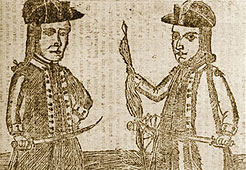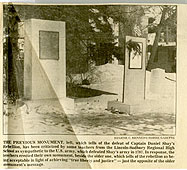For Teachers: Lessons
Lesson 1: Epilogue: Our Debt to Shays
Learning Objectives
After completing this lesson, students will be able to:
- Compare and contrast the views of those who voted for and against ratification of the new Federal Constitution.
- Describe who Daniel Shays was and how and why his name became synonymous with the Regulation.
- Analyze whether Shays’ Rebellion was, or was not, really a rebellion.
- Describe how a variety of historic personalities like Abigail Adams, Alexander Hamilton, George Washington, George Minot and others felt about Daniel Shays and/or Shays’ Rebellion.
- Compare and contrast the ways in which Shays’ Rebellion has been viewed in the more than two centuries since the event. Discuss whether or not the concerns expressed by the Regulators, their sympathizers, and the supporters of the Massachusetts government during the Regulation are still relevant today.
Skills
- Interpreting visual information
- Observing and describing
- Thinking critically
- Expressing opinions
- Analyzing visually
- Understanding historical perspective
- Gathering and using information
- Interpreting information
- Interpreting maps
Introduction
In 1788, Massachusetts became the sixth state to ratify the new Federal Constitution when the Massachusetts ratifying convention voted to accept the proposed plan of government. In the years following ratification, the turmoil of the mid-1780s faded into memory, and became known as “Shays’ Rebellion.”
 |
 |
| 1787 woodcut showing Daniel Shays and Job Shattuck. Courtesy National Portrait Gallery, Smithsonian Institution, Washington, DC | 1987 newspaper article from the Barre Gazette showing temporary monument to Shays |
Guiding Concepts
The basic mistrust and hostility toward distant, centralized government that characterized the Regulation led many communities to vote against ratification. At the same time, fears of renewed turmoil and violence convinced delegates who opposed the Constitution to rally behind the majority decision to ratify. Thus Shays’ Rebellion played a major role in the formation of a new strengthened Federal Constitution. Over time, Shays’ Rebellion has been viewed in a variety of different ways, and Daniel Shays has become somewhat of a folk hero. It can be argued that we are ultimately indebted to the Regulators who raised fundamental questions about the relationship between citizens and their government and the accountability of those who govern. Shays’ Rebellion is a powerful reminder that such questions have always been, and will remain, at the heart of the American experiment.
Preparing to Teach
- Familiarize yourself with the Epilogue: Our Debt to Shays historic scene, linked to from the Historic Scene menu.
- Familiarize yourself with the character narratives of the people mentioned in the Epilogue.
- Google "Shays’ Rebellion" and see how many different accounts of the event you can find. See if you can find any indication of changes in people’s views of the event over time.
Teaching the Lesson
- Class Assignment: Prior to the class period spent on this lesson, make the following website preparation assignment:
- Go to the Epilogue: Our Debt to Shays historic scene from the Historic Scene menu. Read it through, following the links and reading what displays.
- Read the essays for Making a Nation in the Theme section.
- Familiarize yourself with the character narratives of the following people, focusing on their views of Daniel Shays and Shays’ Rebellion: Henry Knox, George Washington, Abigail Adams, Alexander Hamilton. The character narratives are found in the People menu.
- Google "Shays’ Rebellion" and see how many different views of the event you can find. Print them out and bring them to class.
- Class Activity: Reading the Map of Ratification: Project the “Massachusetts Towns Vote to Ratify the Constitution in 1792” map, you can find this on the Map menu, and lead a discussion about what the map displays. Ask students if they know why the Shaysites towns did not vote for ratification. See if they can relate what they have learned about various characters (e.g., Henry McCulloch, Luke Day, Seth Catlin, Agrippa Wells, etc.) to how their towns voted. Why were some towns divided?
- Class Activity: The Evolving Legacy of Shays’ Rebellion. Engage the class in a discussion of how Daniel Shays and the rebellion named for him, have been viewed over the past 200 plus years. Use a blackboard or white board and list phrases that indicate various viewpoints. Begin with the immediate aftermath of the event in the late eighteenth century, drawing upon comments of people like Abigail Adams, Alexander Hamilton, Henry Knox and George Washington. In addition, you can use George Minot's recollections, published in 1810. Then move on to the 1920s as indicated by the Petersham Monument of 1927. End with the Petersham Monument of 1987. Use the discussion questions below.
- Class Discussion Questions:
- How many delegates to the Massachusetts ratifying convention voted to adopt the Constitution? How many voted against it? Do you think former Regulators were more likely to oppose or support ratifying the Constitution? What about their opponents?
- How close was the vote to ratify the Constitution? (passed by only 19 votes) Why did so many delegates vote against it?
- Why did Agrippa Wells vote against ratification of new Federal Constitution? How was his action counter to what his town of Bernardston wanted?
- How did Benjamin Lincoln and George Washington feel about the result of the ratification vote?
- Who was Daniel Shays? How and why do you think his name became synonymous with the Regulation? Do you think what happened in 1786-87 in Massachusetts was a rebellion? Why or why not?
- Consider the concerns expressed
by the Regulators, their sympathizers, and the supporters
of the Massachusetts government during the Regulation.
Do you think any of these issues are still relevant today?
If so, which ones?
- What was George Washington’s opinion of Daniel Shays? (He was “the dupe of some characters who are yet behind the curtain.)
- What was Alexander Hamilton’s opinion of Daniel Shays? (desperate debtor)
- What was George Richard Minot’s opinion of the Regulation? Do you think the Regulation was a rebellion? Why or why not? Cite evidence for your opinion.
- What was Abigail Adam’s opinion of the Regulation? (engineered by “Ignorant, restless desperados, without conscience or principles” who “led a deluded multitude to follow their standard)
- Describe the two monuments to Shays’ Rebellion in Petersham. How do the pictures they paint of the rebellion differ from each other? Which view do you favor? Why?
- How have people’s view of Shays’ and the Regulation changed over time?
- What is a folk hero? Do you consider Daniel Shays a folk hero? Why or why not?
- Is the story of Shay’s Rebellion a myth? What is a myth? Cite evidence for your opinion.
- Do you think we owe a debt to Daniel Shays and Shays’ Rebellion? Why or why not?
Additional Resources
Books and Articles
- Gordon S. Wood, "Conspiracy and the Paranoid Style: Causality and Deceit in the Eighteenth Century,"William and Mary Quarterly 3d ser., 39 (1982): 401-406
- Gross, Robert, ed. In Debt to Shays: The Bicentennial of an Agrarian Rebellion, volume 65. Boston, MA: The Colonial Society of Massachusetts, 1993.
- Richards, Leonard. Shays’s Rebellion: The American Revolution’s Final Battle. Philadelphia: University of Pennsylvania Press, 2002.
- Starkey, Marion. A Little Rebellion. New York: Knopf, 1955.
- Satzmary, David. Shays’ Rebellion: The Making of an Agrarian Insurrection. Amherst, MA: University of Massachusetts Press, 1980.
Websites
- Library of Congress-Historian's Sources: Using Primary Resources
- Library of Congress: Digital Resources Related to the American Revolution
- Library of Congress: American Memory
- Shay’s Rebellion Song
- Best of History Websites: American Revolution and Independence
- PBS: Liberty: The American Revolution
- NEH Edsitement: History and Social Studies
- James Madison Center: US History Curricula
- History Institute, University of Massachusetts: Shays’ Rebellion and Related Resources
Movies
- The History Channel Series: 10 Days That Changed America: Shays’ Rebellion: America’s First Civil War; 60 minutes
- Calliope: A little Rebellion Now and Then: Prologue to the Constitution; 30 minutes